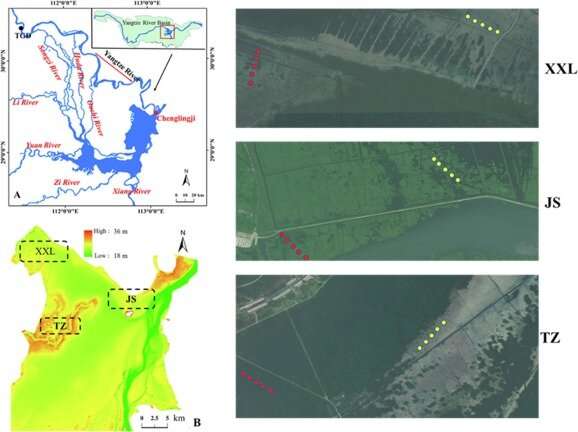Fig. 1. Map of study zones in Dongting Lake wetland. (A) Location of the Dongting Lake in the Yangtze River Basin and its tributaries, (B) sampling and monitoring sites in the Tuanzhou (TZ), Junshan (JS), and Xiaoxi Lake (XXL) wetlands, (C) The yellow dots represent the Carex meadow sampling points, while the red dots are those for the Reed wetland. Credit: DOI: 10.1016/j.catena.2021.105761
Litter decomposition determines the return of carbon (C) to the atmosphere, which plays a key role in carbon balance in terrestrial ecosystems.
Studying the effects of litter decomposition on surface soil organic carbon pool (S-SOCP) during the carbon cycle in different habitats of seasonal flood wetlands is important to further understand the carbon cycle in wetlands.
Recently, a team of researchers from the Institute of Subtropical Agriculture (ISA) of the Chinese Academy of Sciences revealed how hydrological environment influences litter carbon input to S-SOCP in Dongting Lake floodplain of China.
Their study was published in CATENA on Sept. 30.
They investigated the effects of hydrological changes (soil water content and days of flooding) on the litter decomposition process and S-SOCP from January 2018 to November 2019 in the Dongting Lake floodplain, and calculated the contribution of litter to the S-SOCP in Carex meadow and Reed wetland.
"The flooding environment changed the intrinsic limiting factors of litter decomposition and promoted the carbon input of litter," said Zhu Lianlian from ISA, the first author of the study.
In the Carex meadow and Reed wetland, the belowground litter contribution was higher than the aboveground litter during the non-flooding season. While, during the flooding season, the aboveground litter contribution in the Carex meadow was higher, and the belowground litter contributed more in the Reed wetland.
Soil water content showed a positive correlation with soil organic carbon, and a negative correlation with the microbial biomass carbon and dissolved organic carbon in the Carex meadow. However, it indicated a negative correlation with soil organic carbon and a positive correlation with microbial biomass carbon in the Reed wetland during the non-flooding season.
During the flooding season, the variation of dissolved organic carbon was positively correlated with days of flooding in the Carex meadow and Reed wetland.
Soil water content and days of flooding are the main drivers of litter decomposition into the S-SOCP in non-flooding and flooding seasons, respectively. Therefore, the construction of microhabitat with prolonged flooding and relatively higher soil water content are essential ways to improve the carbon sequestration potential in floodplains.
More information: Lianlian Zhu et al, Effects of hydrological environment on litter carbon input into the surface soil organic carbon pool in the Dongting Lake floodplain, CATENA (2021). DOI: 10.1016/j.catena.2021.105761
Lianlian Zhu et al, Factors controlling Carex brevicuspis leaf litter decomposition and its contribution to surface soil organic carbon pool at different water levels, Biogeosciences (2021). DOI: 10.5194/bg-18-1-2021
Journal information: Biogeosciences
Provided by Chinese Academy of Sciences
























